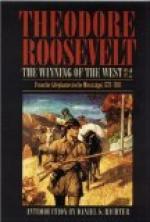The mountaineers had hoped to catch Ferguson at Gilbert Town, but they found that he had fled towards the northeast, so they followed after him. Many of their horses were crippled and exhausted, and many of the footmen footsore and weary; and the next day they were able to go but a dozen miles to the ford of Green River.
That evening Campbell and his fellow-officers held a council to decide what course was best to follow. Lacey, riding over from the militia companies who were marching from Flint Hill, had just reached their camp; he told them the direction in which Ferguson had fled, and at the same time appointed the Cowpens as the meeting-place for their respective forces. Their whole army was so jaded that the leaders knew they could not possibly urge it on fast enough to overtake Ferguson, and the flight of the latter made them feel all the more confident that they could beat him, and extremely reluctant that he should get away. In consequence they determined to take seven or eight hundred of the least tired, best armed, and best mounted men, and push rapidly after their foe, picking up on the way any militia they met, and leaving the other half of their army to follow as fast as it could.
At daybreak on the morning of the sixth the picked men set out, about seven hundred and fifty in number. [Footnote: MS. narrative of Ensign Robert Campbell (see also Draper, 221) says seven hundred; and about fifty of the footmen who were in good training followed so quickly after them that they were able to take part in the battle. Lenoir says the number was only five or six hundred. The modern accounts




